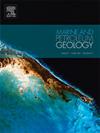五峰—龙马溪页岩纹层特征对孔缝连通性的影响
IF 3.6
2区 地球科学
Q1 GEOSCIENCES, MULTIDISCIPLINARY
引用次数: 0
摘要
非常规页岩系统的孔隙-裂缝连通性主要受纹层控制,因此需要从多个角度进行综合研究。因此,为了定量评价纹层及其特征对孔隙-裂缝连通性的影响,采用光学显微镜和场发射扫描电镜结合Wood's金属浸渍法,结合压汞毛细管压力分析、渗透率测试和纳米压痕实验对川南五峰—龙马溪海相页岩样品进行了研究。结果表明,通过岩石学观察可知,3种类型的孔缝连通性由好到差依次为:富粉质有机质纹层(η = 0.42 ~ 0.47);富粉质粘土纹层(η = 0.36) >;富粘土纹层(η = 0.20)。富粉砂质有机质的层状岩具有较高的有机质丰度、发育良好的有机质孔隙和有利于其连通性的层间裂缝,因此层状岩的连通性最好。而富粘土矿物纹层的连通性较差,主要是由于其有机质含量较低,并且在粘土矿物中以孤立的、细长的孔隙为主。页岩渗透率各向异性主要受矿物组成和微裂缝发育程度的影响,其中富粉质有机质纹层微裂缝分布最广,由脆性矿物组成的刚性骨架支撑。这使得孔隙-裂缝压缩系数最低,有助于保持良好的连通性和流体流动路径。纳米压痕实验表明,富含粉质有机质的层状物具有最高的弹性模量(E >;30gpa)和硬度(H >;2 GPa)。随着粘土含量的增加,这些力学性能逐渐降低,增加了孔隙坍塌和裂缝闭合的敏感性,从而显著削弱了孔隙-微裂缝的连通性。综上所述,不同类型纹层的孔缝连通性控制着基质向裂缝的供气,直接影响页岩气的产量和采收率。勘探时应优先考虑龙马溪一段TST中下部的富粉质有机质纹层作为“甜点”。这些发现对于评估页岩储层的有利位置,优化油田开发计划,特别是水力压裂,以获得更高的收益和资源利用率具有重要意义。本文章由计算机程序翻译,如有差异,请以英文原文为准。
Impact of laminae characteristics on pore-fracture connectivity in the Wufeng-Longmaxi shale
The pore-fracture connectivity in unconventional shale systems is predominantly governed by laminae, necessitating comprehensive investigations through various perspectives. Thus, to quantitatively assess the influence of laminae and their characteristics on pore-fracture connectivity, optical microscopy and field emission scanning electron microscopy combined with Wood's metal impregnation are employed, integrated with mercury intrusion capillary pressure analysis, gas permeability testing, and nanoindentation experiments on Wufeng-Longmaxi marine shale samples from the southern Sichuan Basin, China. The results indicate that the level of pore-fracture connectivity (from good to poor) in three types of recognized lamina from petrographic observations of the samples follows: silty-organic rich laminae (η = 0.42–0.47) > silty-clay rich laminae (η = 0.36) > clay rich laminae (η = 0.20). Silty-organic rich laminae exhibit the best connectivity due to the higher abundance of organic matter, well-developed organic pores, and interlaminar fractures that facilitate their connectivity. In contrast, clay rich laminae demonstrate the poorest connectivity due to their low organic matter content and the predominance of isolated, elongated pores in clay minerals. Furthermore, permeability anisotropy of shale is primarily influenced by mineral composition and the degree of microfracture development where, silty-organic rich laminae exhibit the most extensive distribution of microfractures, supported by a rigid framework composed of brittle minerals. This results in the lowest pore-fracture compressibility coefficient, which helps maintain superior connectivity and fluid flow pathways. Nanoindentation experiments demonstrated that silty-organic rich laminae will have the highest elastic modulus (E > 30 GPa) and hardness (H > 2 GPa). With increasing clay content, these mechanical properties exhibit progressive reduction, promoting enhanced susceptibility to pore collapse and fracture closure, thereby significantly impairing pore-microfracture connectivity. Overall, the pore-fracture connectivity of different types of laminae controls the gas supply from matrix to the fractures, directly affecting the production and recovery rate of shale gas. During exploration, the silty-organic rich laminae in the middle-lower part of the TST of the Longmaxi Member 1 should be prioritized as the sweet spot. These findings have significant implications for evaluating favorable spots in shale reservoirs, for an optimized field development plans, specifically hydraulic fracturing, for higher gains and resource utilization.
求助全文
通过发布文献求助,成功后即可免费获取论文全文。
去求助
来源期刊

Marine and Petroleum Geology
地学-地球科学综合
CiteScore
8.80
自引率
14.30%
发文量
475
审稿时长
63 days
期刊介绍:
Marine and Petroleum Geology is the pre-eminent international forum for the exchange of multidisciplinary concepts, interpretations and techniques for all concerned with marine and petroleum geology in industry, government and academia. Rapid bimonthly publication allows early communications of papers or short communications to the geoscience community.
Marine and Petroleum Geology is essential reading for geologists, geophysicists and explorationists in industry, government and academia working in the following areas: marine geology; basin analysis and evaluation; organic geochemistry; reserve/resource estimation; seismic stratigraphy; thermal models of basic evolution; sedimentary geology; continental margins; geophysical interpretation; structural geology/tectonics; formation evaluation techniques; well logging.
 求助内容:
求助内容: 应助结果提醒方式:
应助结果提醒方式:


